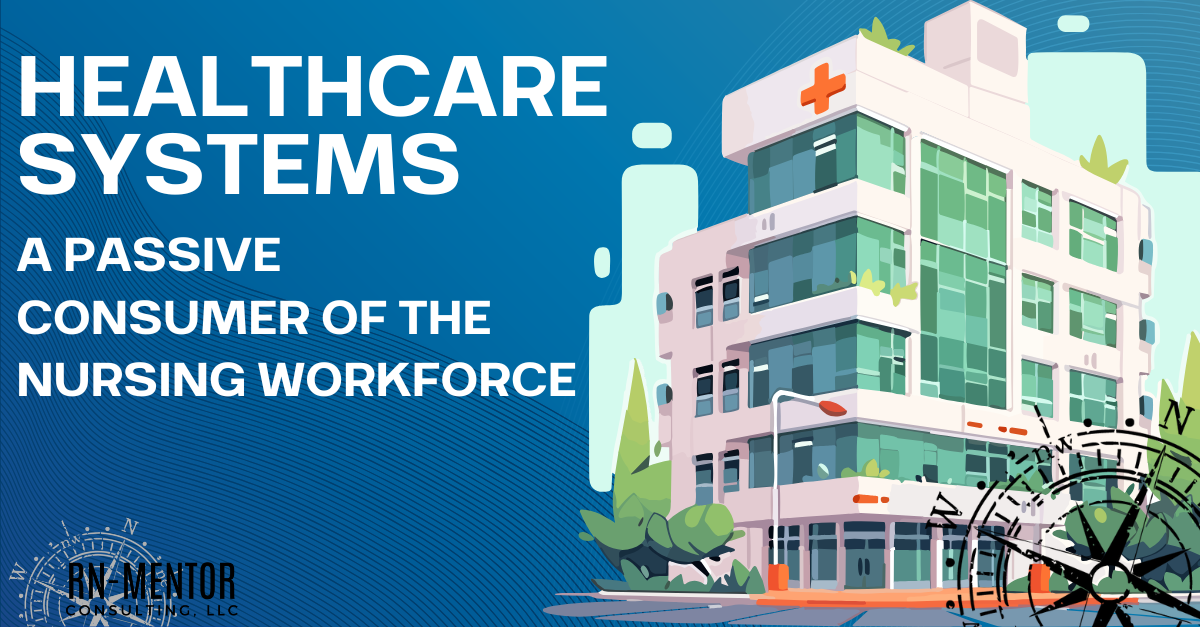Healthcare Systems: A Passive Consumer of the Nursing Workforce
I was part of a conversation in recent week where a nurse executive brought up how she just terminated three new nurses and started to complain about how nurses are not practice ready. Practice ready is a trigger word for me and the notion does not exist in our current systems of nursing education!!! I know for a fact this particular organization has a 3 week new graduate program, unprepared preceptors, zero other support, a low scope of practice for it’s nurses and a high RN turnover rate. With decreasing clinical placements, unprepared preceptors, lack of faculty , and a healthcare system that have become consumers of nursing I felt I needed to have this discussion again!
There was a time when nursing schools were inseparable from the hospitals they served. Education was embedded within the walls of the institution, and nurse learners were seen as part of the clinical fabric rather than an external product delivered from elsewhere. Hospitals housed diploma programs, and the preparation of nurses was viewed as a shared responsibility, not an outsourced function. Although those programs carried their own inequities and limitations, they reflected an era in which hospitals understood that sustaining a nursing workforce required direct participation in its development. As nursing education shifted into colleges and universities, that shared responsibility began to erode. Over time, healthcare systems stepped back from the educational process and adopted a new posture, one that treated the nursing pipeline as something happening “somewhere else.”
For decades, healthcare systems have behaved as if the nursing workforce simply materializes, fully formed and readily available. It is one of the most quietly harmful assumptions in modern healthcare. The idea that nurses, nursing faculty, and the entire educational infrastructure behind them will always be there has allowed health systems to operate as passive consumers of a professional pipeline they do not meaningfully invest in. Everything about today’s workforce challenges tells us that this approach no longer works, if it ever truly did.
Nursing education has long been externalized. Schools recruit the students, educate them, socialize them into the profession, absorb the costs of simulation labs, hire faculty who are paid far below their clinical worth, and manage the complexities of accreditation. Meanwhile, healthcare systems position themselves as the downstream beneficiaries of that labor, expecting fully prepared clinicians to arrive at their doors ready to plug into increasingly complex care environments. The pipeline is treated as someone else’s responsibility, as though academia is a factory, nursing faculty are the assembly line, and students are the product. The system’s job is merely to “purchase” the finished nurse. This passive consumption model is rooted in outdated assumptions about nursing as a profession with a limitless workforce, one predominantly staffed by women who are expected to serve, stretch, and persist regardless of conditions.
This expectation alone has shaped decades of workforce strategy. Nursing has been framed as elastic, able to expand and contract on demand, so when shortages arise, the response is reactive rather than developmental. Increase sign-on bonuses. Call travelers. Nurses working multiple full time positions. Offer relocation incentives. Initiate a retention initiative or two. Hope the problem resolves itself. The idea of investing upstream, such as co-funding faculty lines, supporting academic partnerships, or building internal educational capacity, rarely enters the conversation because strategic thinking has been replaced by short-term financial survival mode. Quarterly margins matter. Long-term workforce stability does not show up neatly on a balance sheet.
Compounding this passivity is a profound misunderstanding of what nursing education actually entails. Too often, leaders equate education with procedural training, checking off skills, teaching workflows, or learning tasks. However, nursing education is cognitive, theoretical, ethical, relational, cultural, highly regulated, and anchored in discipline-specific science. It requires faculty development, curriculum design, simulation pedagogy, research, evaluation, and a deep understanding of how people learn under stress, in teams, and in complex environments. When leaders do not understand the depth of this work, they undervalue it and default to believing academia will somehow manage.
Meanwhile, nursing schools and healthcare systems operate on completely different incentive structures. Academia moves deliberately and very slowly. It focuses on scholarship, accreditation, curriculum, and board exams. Healthcare systems move to prioritizing cost savings, efficiency, productivity, and immediate financial metrics. (Some of you are probably screaming out patient safety and outcomes… Yes, those are all financially incentives and as such prioritized by health systems). These competing forces create a structural tension that neither side has adequately resolved. Without aligned incentives, the collaboration required to sustain a robust workforce pipeline becomes fragmented at best and nonexistent at worst.
The consequences of this passivity are playing out in real time: chronic faculty shortages, overwhelmed clinical sites, escalating burnout, high turnover, new grad and residency bottlenecks, and an ever-increasing dependence on temporary labor. Healthcare systems now spend extraordinary amounts of money fixing problems that could have been prevented with stable, intentional, long-term investment. The nursing workforce is not a product to be consumed. It is a professional community that must be cultivated.
To move forward, healthcare systems must shift from passive consumers to active co-creators. They must invest in faculty, simulation infrastructure, academic partnerships, and internal academies that create clear pathways from novice to expert. They must treat nursing as a discipline of knowledge, not merely labor tied to staffing grids. They must plan ten years ahead, not ten weeks ahead.
The nursing workforce is not a renewable resource that magically regenerates itself. It is a living ecosystem shaped by the decisions, investments, and values of the institutions that rely on it. If healthcare leaders want a sustainable future, they cannot simply wait for the next cohort of graduates. They must help build the systems that make those graduates possible.
That shift will require something fundamental, moving from consuming the workforce to cultivating it.


